-40%
SANTANA - ALL ACCESS PASS - AUTHENTIC FROM SHOW - BUT DON’T KNOW WHICH SHOW??
$ 52.8
- Description
- Size Guide
Description
SANTANA - ALL ACCESS PASS - AUTHENTIC FROM SHOW - BUT DON’T KNOW WHICH SHOW??.A BEAUTIFUL SANTANA ALL ACCESS PASS BUT NOT SURE WHICH SHOW I GOT IT FROM, SORRY!
Santana is an American rock band formed in San Francisco in 1966 by Mexican-American guitarist and songwriter Carlos Santana. The band has undergone multiple recording and performing line-ups in its history, with Carlos Santana the only consistent member. Santana had early success with their appearance at Woodstock in 1969 and their first three albums, Santana (1969), Abraxas (1970), and Santana III (1971). Other important core members during this period include Gregg Rolie, Michael Carabello, Michael Shrieve, David Brown, and José "Chepito" Areas, forming the "classic" line-up.
Following its initial success Santana experimented with elements of jazz fusion on Caravanserai (1972), Welcome (1973), and Borboletta (1974). Santana reached a new peak of commercial and critical success with Supernatural (1999) and its singles "Smooth", featuring singer Rob Thomas, and "Maria Maria". The album reached No. 1 in eleven countries and sold 12 million copies in the US. In 2014, the "classic" line-up reunited for Santana IV (2016) and the group continue to perform and record.
Santana is one of the best-selling groups of all time with 43.5 million certified albums sold the US, and an estimated 100 million sold worldwide.[7][8] Its discography include 25 studio albums, 14 of which reached the US top 10. In 1998, the line-up of Santana, Rolie, Carabello, Shrieve, Brown, and Areas was inducted into the Rock and Roll Hall of Fame.[9] In 2000, the band won six Grammy Awards in one night, a record tied with Michael Jackson, and three Latin Grammy Awards.
1967–1972: Formation and breakthrough Edit
The band was formed in San Francisco in 1966 by Mexican-American guitarist Carlos Santana as the Santana Blues Band with the help of guitarist Tom Fraser.[11] The five-member line-up consisted of Santana on lead guitar, Marcus Malone on percussion, Rod Harper on drums, Sergio "Gus" Rodriguez on bass, and Gregg Rolie on lead vocals and organ. After their first audition, performing with Family Dog at the Avalon Ballroom in the late summer of 1967, concert promoter Chet Helms told the band that they could not achieve success playing Latin-infused rock and suggested Carlos keep his day job as a dishwasher at Tick Tock's Drive-In.
By 1969, the band had secured a record deal with Columbia Records[12] and Bill Graham as manager. Malone had already left the band by this point, as he had been convicted of manslaughter and had started his sentence in San Quentin State Prison. That May, the band entered Pacific Recording Studios in San Mateo, California and recorded their debut album, Santana. Composed mostly of instrumental rock tracks, the album contains their first two singles, "Jingo" and "Evil Ways". To promote their debut album Graham, who was asked to help organise the upcoming Woodstock festival, agreed to on the condition that Santana would be added to the bill. Santana performed a 45-minute set in the afternoon of August 16, the second day. The performance launched the group to international fame, and the album, released on August 30, 1969, peaked at No. 4 on the Billboard 200. "Evil Ways" went to No. 9 on the Billboard Hot 100.
In April 1970, Santana returned to the studio to record its second album, Abraxas.[13] The album, highlighted by a reworking of "Black Magic Woman" by Fleetwood Mac that peaked at No. 4 in the US Billboard Hot 100, was released in September 1970 and rose to number 1 on the US Billboard 200.
By 1971, the group were still struggling to maintain a strong musical direction.[12] From January to July they recorded Santana III. Released in September 1971, the album also reached number 1 on the US Billboard 200. At the peak of the band's popularity, the album was the last to feature its classic Woodstock era line-up. Santana explained that there was a lot of unnecessary internal resentment and that managerial problems contributed to the problem, leading to Graham's dismissal.[12] That year, they performed at a concert in Accra to commemorate Ghana's 14th Independence Day. The concert was filmed and released as Soul To Soul in theaters.[14]
In 1972, Santana had been increasingly influenced by the music of Miles Davis, John Coltrane, and Joe Zawinul, who had explored jazz fusion by this time.[12] The fourth album, Caravanserai (1972), marked a number of line-up changes; bassist David Brown left in 1971 before recording started and was replaced by Doug Rauch and Tom Rutley. Carabello was replaced with two percussionists, Armando Peraza and Mingo Lewis. Rolie was replaced by Tom Coster on a few songs. Caravanserai debuted at number 8 on the pop charts, despite not spawning a hit single.
1973–1979: Experimentation and consolidation Edit
13 months after Caravanserai, Santana released Welcome. Welcome was the first of four consecutive albums to achieve gold certification, as opposed to the previous four, which all at least reached platinum status. The album peaked at number 25 on the Billboard 200, the lowest of the band's career so far. The next few albums contained a more experimental style than their previous work, beginning with Borboletta, which fared arguably worse than its predecessor, despite climbing five spots higher on the Billboard album charts in the US.
The group's 1976 release, Amigos, was far more successful. Reaching number 10 on the US charts, and also hitting the top 10 in France, Australia, New Zealand, Austria and the Netherlands, it was a return to the success of their early albums. Festival, somewhat contradicted that new-found success, but was a short blip before another successful album, Moonflower, released in 1977. The album was possibly the most successful since Santana III, achieving 2x platinum in the US, and being the first album since 1974's Borboletta, to break the top 10 in the UK. It was characterized by a stylistic shift for the band, as it contained heavier influences from the more conventional sound of the group's early work, while still maintaining the experimental sound of their last few albums.
Their next two releases, Inner Secrets and Marathon, released in 1978 and '79, respectively, were a further musical shift for the band, moving away from the Latin-fused rock music that had characterized their work in the late 1960s and the majority of the '70s, to move towards a more album-oriented, conventional rock sound. These albums, however, fared poorly commercially, although both achieved gold status in the US.
1980–1997: Commercial decline and seven-year hiatus Edit
The 1980s started relatively brightly for Santana, with 1981's platinum-selling Zebop!, which also reached the top 20 in several countries, and continued the more conventional rock sound. The following year, Shangó was released; this album marked a steep decline in the band's commercial fortunes, although it still achieved gold status.
The group waited another three years to release the follow-up, the longest break for them so far. 1985's Beyond Appearances was a commercial failure, and their first album not to achieve gold certification. Their following three releases all continued this commercial decline, with the last of these failing to break the Billboard top 100. In the midst of this commercial pitfall, the band stopped recording material for an unprecedented seven years but continued to tour.
1998–2001: Supernatural and the Rock and Roll Hall of Fame Edit
In 1998, Santana was inducted into the Rock and Roll Hall of Fame. The following year, their album Supernatural (1999) debuted at number 19 on the Billboard 200 and reached No. 1 after eighteen weeks. Also reaching No. 1 were two singles: "Smooth", recorded with Rob Thomas, and "Maria Maria". The album was certified platinum 15 times by the RIAA and sold 30 million copies worldwide.[citation needed] Santana's previous number one album had been Santana III in 1971. According to Guinness World Records, this is the longest gap between number one albums.
Supernatural won nine Grammy Awards, including the award for Album of the Year, and also won three Latin Grammy Awards, including Record of the Year.
The follow-up to Supernatural came three years later and was highly anticipated by international media and fans alike. On October 22, 2002, Shaman was released worldwide. Although it initially sold briskly (298,973 copies in the US in its first week) and debuted at number 1 on the Billboard 200, the album's appeal quickly wore off and it soon slid down the charts. Despite this, it went on to sell 2x platinum in the US, and achieved platinum status in several other countries including Australia. The first single released from the album, "The Game of Love", which featured vocals from Michelle Branch, debuted at number 5 on the Hot 100. The album's next four singles failed to chart in most countries, but the final single, "Why Don't You & I", featuring the vocals of Alex Band, reached number 8 on the Hot 100. Musically, the album was a return to a more conventional sound for the group, with a mainly Latin rock-based sound.
With their renewed appeal worn off, another three-year wait saw the release of 2005's All That I Am. The album debuted at number 2 on the Billboard 200 but fared worse internationally, and quickly lost appeal. The album, a continuation of the Latin-rock influenced sound of Shaman, achieved gold certification in the US. A five-year break from recording saw the release of another studio album, Guitar Heaven (2010). Musically it was a drastic change for the band, with a far heavier sound at its core and strong heavy metal influences. It debuted at number 5 on the Billboard 200 but marked another decline for the band, failing to achieve gold status.
In 2012 the group released Shape Shifter, which returned to the conventional Latin rock sound and was completely album-oriented, as no singles were released from it. It debuted at number 16 on the Billboard 200.
2013–present: Reunion of the classic line-up, Corazón, Santana IV, and Africa Speaks Edit
On 2 February 2013, Carlos Santana confirmed that he would reunite his classic line-up, most of whom played Woodstock with him in 1969. Santana stated that he was reuniting the group with the intention of recording new music. Confirmed for the reunion were Neal Schon, who was in the band in the early 1970s where he traded lead guitar work with Santana before leaving with founding Santana singer-organist Gregg Rolie in 1973 to form Journey; drummer Mike Shrieve and percussionist Mike Carabello. Santana said of Rolie, who played with Ringo Starr's All-Starr Band for the last two years, "I'm pretty sure Gregg's going to do it." In February 2013, Rolie told Radio.com, "it's (the reunion) just a matter of putting it together and going and doing it. I would do it. I think it's a great idea. People would love it. It could be great!"[15]
In the meantime, Santana released on 6 May 2014 a new studio album entitled Corazón and on 9 September 2014, Corazón – Live from Mexico: Live It to Believe It, a new live album (on CD, DVD and Blu-ray) of their show on 14 December 2013 in Guadalajara, Mexico.[16]
On 15 April 2016, Santana released Santana IV, the wildly anticipated studio album that reunited the early 1970s classic lineup of Carlos Santana (guitar, vocals), Gregg Rolie (keyboards, lead vocals), Neal Schon (guitar, vocals), Michael Carabello (percussion) and Michael Shrieve (drums). The album marked the first time in 45 years – since 1971's multi-platinum classic Santana III – that the quintet had recorded together.[17]
The origins for the reunion go back several years, when Schon suggested that he and Carlos Santana record together. Santana liked the idea but went one better, proposing that they recruit Rolie, Shrieve and Carabello for what would be called "Santana IV". After initial writing sessions and rehearsals took place in 2013, the group recorded throughout 2014 and 2015, amassing 16 new tracks that combined all their signature elements – Afro-Latin rhythms, soaring vocals, electrifying blues-psychedelic guitar solos, and irrepressible jubilant percussion work.
About the "Santana IV" team, Santana stated: "It was magical, we didn't have to try to force the vibe – it was immense. From there, we then needed to come up with a balance of songs and jams that people would immediately identify as Santana."[18]
Santana IV features 16 all-new tracks written and produced by the band. Joining the core "Santana IV" band in the studio are current Santana members Karl Perazzo (percussion) and Benny Rietveld (bass), with vocalist Ronald Isley guesting on two cuts.
The first single from Santana IV, entitled "Anywhere You Want to Go", was released on 5 February 2016.[19]
On 21 October 2016, Santana released Santana IV: Live at the House of Blues Las Vegas on Eagle Rock Entertainment, a new (151 minutes) live album (on DVD/Blu-ray/2CD) of their concert on 21 March 2016 at House of Blues in Mandalay Bay Resort and Casino on the Las Vegas Strip in Nevada.
In early January 2019, Santana signed with Concord Records[20] and on 25 January, they released In Search of Mona Lisa, a new (5-track) EP.[21] The day before, they also released a video for new single, "Do You Remember Me."[22] In March 2019, the band announced plans to release on June 7, 2019, Africa Speaks, their new full-length album produced by Rick Rubin.[23]
2019 marked the 20th anniversary of Carlos Santana's iconic album, Supernatural, and the 50th anniversary of his legendary performance at Woodstock. Santana headlines a multi-year residency at House of Blues. The band headlined at both Woodstock 50 (which was cancelled)[24] and Bethel Woods' half-centennial celebration in Bethel, NY, in August 2019.[25] The band toured in support of the latest album, from April to November 2019.










